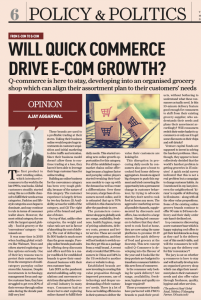
Apart from stock market, Retail is the only business looking visibly impacted by Corona globally. Malls and high streets are shutting down due to lock-downs whereas on the other hand supermarkets, pharmacy stores, food stores and online stores are experiencing a different surge. Panic buying, shortages and huge drop in fulfillment rate of online retailers are throwing different set of challenges to these businesses. Globally, it is looking the same.
On Sunday, 22nd March during the Janata Curfew, I decided to explore the bottom of this through a brainstorming session with the thought leadership across the industry. I invited 35 such leaders over a hangout session followed by a message to join with very little context. To my surprise, 18 of them joined the session and thanks a lot to all of them for taking time out. It was a mixed group of retail CIOs, Innovators and Retailers. Started with probing CIO’s on impact on their work daily life, kind of discussions & management talks and challenges and issues.
Since most lifestyle brands have to shut stores, they are trying to figure out how to liquidate inventory through other channels. With uncertainty on timelines of this situation fashion merchandise becomes highly perishable. Can we rely only on online channels to dispose all of it and if yes, then at what price? Is pushing large inventory in unorganized sector a choice? On top of this, managing logistics issues associated with it is another huge problem to deal with.
Electronics retailers experienced huge surge in demand for laptops since majority of workforce needed to be moved to #WFH mode. Thermometer Guns is suddenly becoming a household device and no supplies.
Supermarkets are suddenly overwhelmed by rush of customers for stocking kitchen essentials. Given the dynamics of the Corona situation, panic levels are driven by rise in cases or no. of deaths in each market. Retailers are wondering if they should shrink the overall range to make best use of stocking shelves in their stores. Till now supermarket sales were driven by discounts and offers but now availability is the key factor. On the other hand, there is large range of merchandise which is not moving at all in the same stores. Optimization of pricing of slow or non-moving SKUs to empty the shelves space for fast moving SKUs is another challenge.
Supply Chain managers are struggling with daily allocation of merchandise to their stores optimally since availability is the key factor to manage customer sentiments. Any shortage in the stores leads to panic buying unnecessarily.
Though online traffic has also accelerated across categories but these retailers are largely affected by shortage of manpower on the ground, delivery, warehouse and operations. Large number of front-line manpower across retail businesses has moved back to their native villages due to fear of Corona. I am told some of the retailers have lost 30-40% of their front-line manpower. These were trained and experienced people.On the other hand, large number of front-line workers in hospitality and restaurant segment have moved back to native places since they have no work.
Though there is uncertainly on how long the current situation will last, managing cash flows will be another key challenge. Another set of challenges are expected to unfold once Corona curve starts moving downwards and these retailers start preparing to get back to their normal business. Hiring & training of staff once again, new merchandising based on the season and trends, hiring & training of store staff etc.
Retail leadership is looking for technological solutions to deal with these current challenges but certainly the lessons learnt during this phase will be quite useful for the next phase when get down to put the pieces together.
#coronavirus #GlobalRetail



